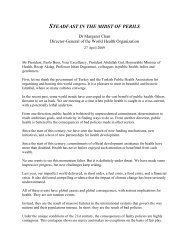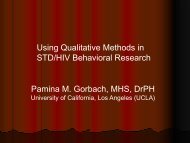The Evolution of HTA in Emerging Markets Health-Care ... - TREE
The Evolution of HTA in Emerging Markets Health-Care ... - TREE
The Evolution of HTA in Emerging Markets Health-Care ... - TREE
You also want an ePaper? Increase the reach of your titles
YUMPU automatically turns print PDFs into web optimized ePapers that Google loves.
OHE Consult<strong>in</strong>g Report for PhRMA<br />
5 January 2011<br />
<strong>HTA</strong> would therefore be helpful <strong>in</strong> determ<strong>in</strong><strong>in</strong>g adoption <strong>of</strong> health technologies, for which the<br />
marg<strong>in</strong>al/<strong>in</strong>cremental health benefits (<strong>in</strong> monetary terms), exceeds the marg<strong>in</strong>al/<strong>in</strong>cremental costs.<br />
A3.10 Future <strong>of</strong> <strong>HTA</strong> <strong>in</strong> Taiwan: F<strong>in</strong>d<strong>in</strong>gs and Issues<br />
Despite its <strong>in</strong>creased importance <strong>in</strong> the drug review process, <strong>HTA</strong> is still currently a pilot project.<br />
<strong>The</strong>re are about ten employees to conduct synthesis <strong>of</strong> evidence and analysis <strong>of</strong> new drugs. All<br />
projects done by D<strong>HTA</strong> are currently delegated by BNHI, so they are subord<strong>in</strong>ate to the DOH and<br />
BNHI. It is, however, f<strong>in</strong>ancially <strong>in</strong>dependent from the BNHI, and aims to make an unbiased,<br />
<strong>in</strong>dependent assessment <strong>of</strong> the evidence.<br />
Accord<strong>in</strong>g to Jirawattanapisal, et al. (2009), there is no legislative <strong>in</strong>strument back<strong>in</strong>g the use <strong>of</strong> <strong>HTA</strong><br />
<strong>in</strong> pharmaceutical reimbursement decisions <strong>in</strong> Taiwan although some progress has been made. In<br />
2007, the M<strong>in</strong>ister <strong>of</strong> <strong>Health</strong> established an <strong>HTA</strong> system under the Centre for Drug Evaluation (CDE).<br />
<strong>The</strong> CDE acts as an adviser to the BNHI – which is the s<strong>in</strong>gle payer for all beneficiaries – <strong>in</strong> all matters<br />
relat<strong>in</strong>g to <strong>HTA</strong>. <strong>The</strong> BNHI (specifically the Drug Benefit Committee (DBC) <strong>of</strong> BNHI) takes<br />
consideration <strong>of</strong> <strong>HTA</strong> evidence as part <strong>of</strong> the <strong>in</strong>formation arsenal for pharmaceutical reimbursement<br />
decision-‐mak<strong>in</strong>g. <strong>The</strong> CDE is thus not a healthcare payer as <strong>in</strong> the case <strong>of</strong> HIRA (the National <strong>Health</strong><br />
Insurance Review and Assessment, which is agency with<strong>in</strong> the NHI) <strong>in</strong> South Korea: it is an<br />
<strong>in</strong>dependent evaluator.<br />
This <strong>in</strong>dependence, however, doesn’t guarantee complete lack <strong>of</strong> bias: <strong>HTA</strong> deliberations and<br />
discussions are not made public <strong>in</strong> Taiwan. Few people outside <strong>of</strong> the BNHI and DBC members have<br />
access to their reports. (It is the BNHI’s decision not to disclose the assessment report, not the <strong>HTA</strong><br />
group.)<br />
Currently, the new law regard<strong>in</strong>g the “second generation” <strong>of</strong> NHI is under review <strong>in</strong> the legislative<br />
Yuan, and is expected to be completed <strong>in</strong> early December <strong>of</strong> 2010. <strong>The</strong>re are two clauses related to<br />
<strong>HTA</strong>. First, it states that BNHI “can” conduct <strong>HTA</strong> analysis <strong>in</strong> apprais<strong>in</strong>g new drug as opposed to<br />
stat<strong>in</strong>g that they “should”; this clause has not yet been approved, which means that <strong>HTA</strong>’s function<br />
or role is still not specified <strong>in</strong> the new law. <strong>The</strong> second clause was approved and stipulates the<br />
follow<strong>in</strong>g: if the BNHI cannot complete <strong>HTA</strong> analysis on a new drug with<strong>in</strong> 90 days <strong>of</strong> the<br />
submission, the BNHI has to directly accept the <strong>in</strong>clusion <strong>of</strong> new drug <strong>in</strong> the reimbursement list.<br />
<strong>The</strong>re can be no delay <strong>in</strong> the approval process due to tard<strong>in</strong>ess from an <strong>HTA</strong> report.<br />
It is noteworthy that the <strong>HTA</strong> assessment report for BNHI has been completed with<strong>in</strong> 42 days s<strong>in</strong>ce<br />
the beg<strong>in</strong>n<strong>in</strong>g, and has never been delayed. <strong>The</strong> decision on reimbursement and pric<strong>in</strong>g is by DBC,<br />
so that is the reason for any delay. <strong>The</strong> <strong>HTA</strong> assessment report does not recommend the list<strong>in</strong>g and<br />
pric<strong>in</strong>g: it is given to the appraisal committee members to review before the DBC meet<strong>in</strong>g, and they<br />
make the recommendation. <br />
<strong>The</strong> BNHI spends about 25% <strong>of</strong> its budget on drugs. However, this important statistic is somewhat<br />
mislead<strong>in</strong>g. <strong>The</strong> fact that the reimbursement level is higher than the acquisition cost means that<br />
providers are paid more by government than the amount they pay to purchase the drugs. This gives<br />
them an <strong>in</strong>centive to prescribe more.<br />
Understand<strong>in</strong>g the role that <strong>HTA</strong> will, can, or should play <strong>in</strong> Taiwan requires an appreciation <strong>of</strong> the<br />
fact that a centralized health care system can behave as a monopsony buyer, negotiat<strong>in</strong>g <strong>in</strong> the case<br />
<strong>of</strong> <strong>in</strong>novative branded drugs with a monopoly seller-‐-‐the manufacturer. <strong>The</strong> price outcome <strong>of</strong> such<br />
a “bilateral monopoly” negotiation is <strong>in</strong>determ<strong>in</strong>ate (<strong>in</strong> terms <strong>of</strong> its relation to marg<strong>in</strong>al cost),<br />
103








